



Find all of your laboratory and workplace safety supplies at Safety Emporium!
 Reproductive Toxin |
 Glossary Index |
 Respiratory |
| MSDS Topics |
Free Sites | FAQ's | Regulations | Glossary | Software | Suppliers |
| Books | Forum | Poll | Fun stuff | Quiz | Store | |
| Understand your MSDS with the MS-Demystifier | Search ALL our MSDS info | |||||

Get your PPE such as NIOSH-approved N95 masks and face shields from Safety Emporium.
A respirator (of the "approved" type) is a device which has met the requirements of 42 CFR part 84, has been designed to protect the wearer from inhalation of harmful atmospheres, and has been approved by the National Institute for Occupational Safety and Health (NIOSH) and the Mine Safety and Health Administration (MSHA).
Note: 42 CFR part 84 supercedes/replaces 30 CFR part 11, effective July 10, 1995. The change dealt primarily with particulate respirators. See https://www.cdc.gov/niosh/npptl/topics/respirators/pt84abs2.html for details.
There are many different kinds of respirators used to prevent or reduce inhalation of hazardous or toxic materials. These fall into two general classes:
 | Air-line respirators (also called an air-supplied respirator or supplied air respirator, SAR). The respirator is connected to a stationary source of compressed breathing air source by a hose. The air is delivered continuously or intermittently in a sufficient volume to meet the wearer's breathing requirements. Obviously, the user is restricted by the length of the hose connection, and the dangers of damage to the hose. Also see this OSHA article, Deaths Involving the Inadvertent Connection of Air-line Respirators to Inert Gas Supplies.
|
 | Self-contained breathing apparatus (SCBA). This is much like the apparatus a SCUBA diver or fire fighter might use. Air is supplied from a compressed cylinder, usually through a full-face mask, which is worn on the back. This gives greater movement than an air-line respirator, but the air supply is limited. |
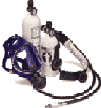 | Combination respirators have a small, auxiliary self-contained air supply that can be used if the primary supply fails. |
In addition, these cartridges/canisters usually do not include any method of indicating when their ability to remove air contaminants has been reduced. Read the manufacturer's instructions for cartridge maintenance and replacement or see the OSHA link below.
There are three basic kinds of air-purifying respirator.
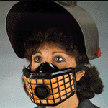 | Particulate respirators use a mechanical filter to remove particulate matter such as dusts. Do not assume that your respirator removes particulates or vapors; READ the labels and manufacturer's instructions. NIOSH has a discussion of particulate filtering classification, marking, and approved labels that explains what terms like N95, R99, and P100 mean. Note: Ear loop surgical-style masks are not classified as respirators. These do not provide a good seal and are generally unacceptable for protection from particulates in occupational settings. |
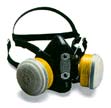 | Gas and vapor respirators (or chemical cartridge respirators) use chemicals such as activated charcoal to remove specific gases and vapors from the air. These are effective for concentrations of no more than ten times the TLV of the contaminant, if the contaminant has warning properties (odor or irritation) below the TLV. |
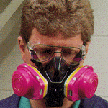 | Combination respirators have filters for both particulates and vapors. Powered air-purifying respirators (PAPR) (not shown) use a blower to force the ambient air through air-purifying elements to the inlet covering. |
Some other respirator terms worth knowing are:
NOTE: We may collect a share of sales or other compensation from the links in the following list:

Safety posters are a terrific way of reminding employees of proper procedure. Get yours at Safety Emporium.
If the material you are working with requires the use of a respirator, this information will be found in Section 8 (exposure controls/personal protection) of the Safety Data Sheet. If the SDS author was competent, a specific type of respirator will be recommended for the particular hazard.
Respirators should be used for protection only when engineering controls (for example, enclosure or confinement of the operation, general and local exhaust ventilation (such as fume hoods), and substitution of less toxic materials) have been shown to be infeasible for the control of the hazard or during the interim period when engineering controls are being installed.
Keep in mind the following facts about respirators:
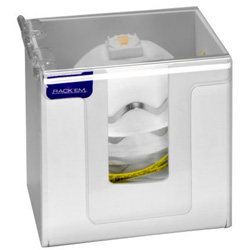
Make your PPE readily available with safety dispensers from Safety Emporium.
See also: asthma, emphysema, fume hood, respiratory.
Additional definitions from Google and OneLook.
Entry last updated: Sunday, January 8, 2023. This page is copyright 2000-2025 by ILPI. Unauthorized duplication or posting on other web sites is expressly prohibited. Send suggestions, comments, and new entry desires (include the URL if applicable) to us by email.
Disclaimer: The information contained herein is believed to be true and accurate, however ILPI makes no guarantees concerning the veracity of any statement. Use of any information on this page is at the reader's own risk. ILPI strongly encourages the reader to consult the appropriate local, state and federal agencies concerning the matters discussed herein.